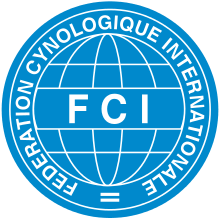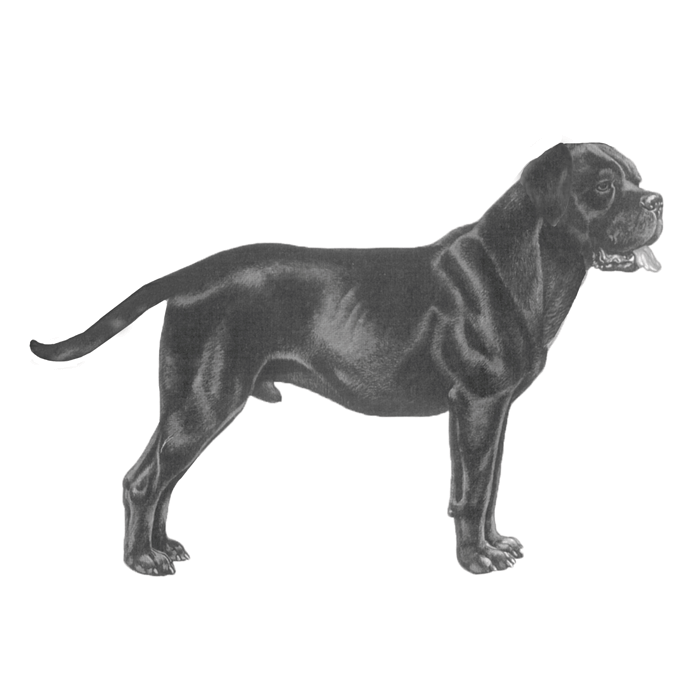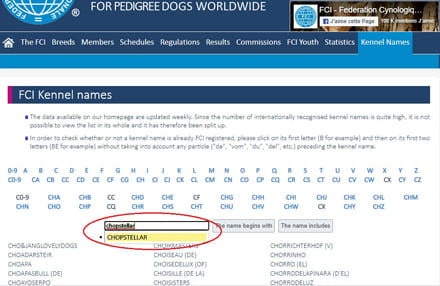Breed strandard Cane Corso Italiano

FEDERATION CYNOLOGIQUE INTERNATIONALE
FCI-Standard N° 343
Date of publication of the official valid standard: 13.11.2015
Italian Cane Corso.
Origin: Italy.
Utilization: Utility dog, polyvalent.
FCI-classification:
- Group 2 Pinscher and Schnauzer, Molossoid and Swiss Mountain and Cattledogs.
- Section 2.1 Molossian, Mastiff type.
- With working trial.
Brief historical summary

Its direct ancestor is the old Roman Molossian. Formerly scattered all over Italy, in the recent past, the breed was only prevalent in the province of Apulia and in the adjacent regions of Southern Italy. His name derives from the Latin «cohors», which means «protector, guardian of the farmyard».
General appearance
Medium to large sized. Robust and sturdy dog, nevertheless with some elegance. Lean and powerful muscles.
Important proportions
The dog is rectangular in outline and is slightly longer than tall. (The length of the dog is 11% greater than the height of the dog). The length of the head reaches 36 % of the height at the withers.
Behaviour / Temperament
Guardian of property, family and livestock; extremely agile and responsive.
In the past, it has been used for herding cattle and hunting big game.
Head
Large and typically molossoid. The upper longitudinal axes of the skull and the muzzle are slightly convergent, without evident wrinkles.
CRANIAL REGION
Skull:
- Broad at the zygomatic arches the width is equal to the length. Convex in front, it becomes flat behind the forehead as far as the occiput. The medio-frontal furrow is visible, beginning at the stop and ending at about the middle of the skull.
Stop:
- Well defined, with prominent frontal sinuses.
FACIAL REGION
Nose:
- Black. A grey mask may have a nose colour of the same nuance. Large nose with ample open nostrils. Nose placed on the same line as the nasal bridge.
Muzzle:
- Strong, square, noticeably shorter than the skull, ratio muzzle : skull approximately 1 : 2. The front part of the muzzle is flat; the lateral surfaces are parallel; the muzzle is as broad as it is long. Seen from the side it is deep. The profile of the nasal bridge is straight.
Lips:
- The upper lips; seen from the front, form an inverted «U» at their meeting point; seen from the side hangs moderately. They cover the lower jaw and determine the profile of the lower part of the muzzle.
Jaws / Teeth:
- Jaws are very large thick and curved. Slightly undershot but no more than 5 mm. Level bite tolerable but not sought after.
Cheeks:
- The masseter region is fully evident, but not bulging.
Eyes:
- Medium-sized, slightly protruding, but never exaggerated. Close to ovoid in shape, set well apart in an almost sub-frontal position. Eyelids close fitting. The colour of the iris is as dark as possible but according to the coat colour. Expression is keen and attentive.
Ears:
- Triangular, drooping, of medium size. With a wide set-on that is much above the zygomatic arches. Ears are un-cropped.
Neck
Strong, muscular, as long as the head.
Body
The body is somewhat longer than the height at the withers. Sturdy built but not square.
- Withers: Pronounced, rising above the level of the croup.
- Back: Straight, very muscular and firm.
- Loin: Short and strong.
- Croup: Long and wide, slightly inclined.
- Chest: Well developed all through reaches to the elbow.
Tail
Natural. Set on fairly high; very broad at the root. In action carried high, but never erect or curled.
Limbs
FOREQUARTERS
- Shoulder: Long, oblique, very muscular.
- Upper arm: Strong.
- Forearm: Straight, very strong.
- Carpus (Wrist): Elastic.
- Metacarpus (pastern): Elastic and just slightly sloping.
- Forefeet: Cat feet.
HINDQUARTERS:
- Thigh: Long, broad, back line of thigh convex.
- Lower thigh: Strong, not fleshy.
- Stifle (Knee): Solid, moderately angulated.
- Hock joint: Moderately angulated.
- Metatarsus (Rear pastern): Thick and dry.
- Hind feet: Slightly less compact than the forefeet.
Gait / Movement
Long stride, extended trot; the preferred gait is the trot.
Skin
Fairly thick, rather close fitting.
Coat
Hair:
- Short, shiny, very dense with a slight undercoat of vitreous texture.
Colour:
- Black, lead-grey, slate-grey, light grey, light fawn; dark fawn and stag red; dark wheat colour (stripes on different shades of fawn or grey); in fawn coloured and brindle dogs the black or grey mask on the muzzle should not go beyond the line of the eyes. A small white patch on the chest, on the tip of the toes and on the bridge of the nose is acceptable.
Size and Weight
Height at the withers:
- Males: 64 cm – 68 cm.
- Females: 60 cm – 64 cm.
With a tolerance of 2 cm, more or less taller.
Weight:
- Males: 45 – 50 kg.
- Females: 40 – 45 kg.
Weight according to the size of dog.
Faults
Any departure from the foregoing points should be considered a fault and the seriousness with which the fault should be regarded should be in exact proportion to its degree and its effect upon the health and welfare of the dog and its ability to perform its traditional work.
Severe faults
- Axes of muzzle and skull parallel or very marked converging; lateral surfaces of the muzzle converging.
- Partial depigmentation of the nose.
- Scissor bite; undershot bite more than 5 mm.
- Ringed tail, tail in vertical position.
- Permanent amble when trotting.
- Over-or under size.
- Presence of dewclaws.
Disqualifying faults
- Aggressive or overly shy dogs.
- Any dog clearly showing physical or behavioural abnormalities shall be disqualified.
- Axes of muzzle and skull diverging.
- Total depigmentation of the nose.
- Bridge of nose concave or convex (Roman nose).
- Overshot mouth.
- Partial or complete palpebral depigmentation. Wall eye (blue flecked); strabism (squinted).
- Tailless, too short tail.
- Semi-long, smooth or fringed hair.
- All colours not indicated in the standard; large white patches.
N.B
- Male animals should have two apparently normal testicles fully descended into the scrotum.
- Only functionally and clinically healthy dogs, with breed typical conformation, should be used for breeding.


